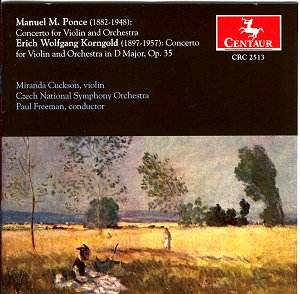Both concertos date from within six years of each other;
Korngold’s from 1937 to 1939, Ponce’s in 1943. Frankly there is all
the difference in the world between them, with Korngold’s the far superior
in melodic invention, orchestration and sensual pleasure. Ponce’s work
never really gets itself off the ground, seems to be searching for a
style other than the French-Mexican brew to which it constantly returns.
Ponce became a great friend of Segovia and wrote his best music for
the guitar, whereas here he seems restrained in his harmonic vocabulary
and a far cry from modernism. Not that Korngold breaks the bounds of
tonality; on the contrary he concocts a mélange of featherbedded,
lush instrumentation and Hollywood melodies that have been and are still
being emulated down the years in all sorts of blockbuster movies. Ponce’s
concerto is a late work with reminiscences of his youth and later studies
with Dukas in Paris in the late 1920s and early 1930s. The Mexican flavour
lies predictably enough in the rhythmic underlay of the accompaniment,
with dances such as the mestizo or the fandanguito, and
strummed backgrounds in guitar-like colours. In the second movement
Ponce recalls a youthful success, his arrangement of the folksong Estrellita
which made him famous in 1910. The finale fuses traditional Mexican
dance once again this time with the corrido, a narrative ballad.
Miranda Cuckson does her best for Ponce but succeeds
far more with Korngold, and that goes for the orchestra too. Ponce’s
concerto gets a dull performance while in Korngold’s all the players
get to the heart of the music from the start. Ponce’s concerto may well
grow on you, but the disc is worth having for the Korngold, though here
again the competition is tough starting with Heifetz.
Christopher Fifield


